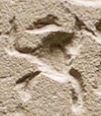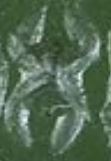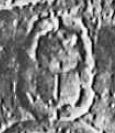| Phonetic value |
Semantic value |
Use |
|
|
ḫpr
|
to become
|
regular
|

|
Tokens
| Token | Source | Date |

|

ḫpr.n=k
you have come to be
|
Unas
|

|

jw nwꜣ ḫpr
while these came to be
|
6th Dynasty
|

|

jw bꜣk.n=(j) wꜣwꜣ,t(j).w n [ḥr(.j)-tp] nb ḫpr(.w) m spꜣ.t 〈t〉n
I taxed the people of Wawat on behalf of every chief who had arisen in this area
|
1st Intermediate Period
|

|

nfr qd sbꜣ.n bjꜣ.t=f mj ẖrd ḫpr m-ꜥ jt
one who is good of character, whom his nature has taught, like a child comes to be through the father
|
11th Dynasty (after reunification)
|

|

ḥr ḫpr=j m ḥꜥ.w n(.w) nṯr pn špsj
because I come to be from the body of this noble god
|
Mentuhotep II Nebhepetre (complete reign)
|

|

ḫpr.n tp wꜣ.t nfr.t m rdj.t mnṯw tꜣ.wy n jt(.y) nb-ḥp.t-rꜥ ꜥnḫ ḏ.t
(since) the beginning of a good path came to be when Montu gave the two lands to the sovereign Nebhepetre, living eternally.
|
Mentuhotep II Nebhepetre (complete reign)
|

|

tm.n ḫpr zp th m ꜥ=f ḏr hꜣ.t r jr.t wpw.(w)t
One by whose hand never happened an occasion of wrongdoing since the appointment to "do missions".
|
Mentuhotep II Nebhepetre (complete reign)
|

|

wr n rṯn.w ẖs ꜥ.wy ḫmt qn.w m jb=f n ḫpr=sn n=f
the chief of Retjenu, weak of arms, who plans many things in his heart, they did not happen for him.
|
Kamose
|

|

ḫpr swt snḏm ḥm=f m ḏꜣd.w nswt bj.ty nb-pḥ.ty-rꜥ sꜣ-rꜥ jꜥḥ-msjw dj ꜥnḫ
It happened that his majesty rested in the audience hall, the king of upper and lower Egypt, Nebpehtire, son of Re Ahmose, given life,
|
Ahmose Nebpehtyre
|

|

nṯr ꜥꜣ ꜥꜣ-ḫpr-kꜣ-rꜥ
The great god, Aakheperkare.
|
Tuthmosis I Aakheperkare
|

|

dj=j m-ḥr-n ḥnmm.t ḫpr.t=sn n ḥn.ty
I offered in the sight of the sunfolk, they who will come to be in the future,
|
Hatshepsut Maatkare
|

|

jmn-rꜥ ꜥꜣ hmhm nb r nḥḥ ḥqꜣ ḏ.t ḫpr ḏs=f
Amun-Ra, great of roar, lord of eternity, sovereign of eternity, who brought himself into being,
|
19th Dynasty
|

|

sḫr.w=f ḫpr sḫr n=f
his enemies, who became cast down for him
|
Ramesses III Usermaatre-Meriamun
|

|

sḫr.w=f ḫpr sḫr n=f
his enemies, who became cast down for him
|
Ramesses III Usermaatre-Meriamun
|

|

ṯḥḥ.wt ḫpr.tj m ḫt-mn
The exultation comes to be in Egypt
|
Cleopatra VII Philopator
|

|

ḥr-smꜣ-tꜣ.wy nb ḫꜣ-dj nṯr ꜥꜣ ḥr(.y)-jb jwn.t rꜥ pw ḫpr ḏs=f m sp tp(.y)
Harsomtus, lord of +txA-di+l, great god, who resides in Dendera, it is Re who came to be by himself the first time
|
Cleopatra VII Philopator
|

|

wnn nbj ḥḥ nṯr ḫnt ḥw.t-smꜣ-tꜣ.wy nḥb-kꜣ.w grg tꜣ pn ḥr qmꜣ ḥḥ.w ḥr sḫpr ḥfnw.w ḥr rdj(.t) ꜥnḫ n ꜥnḫ.w
The one who fasioned Heh, the god in front of the mansion of uniting the two lands, Nehebkau who establishes this land, is creating millions, creating hundreds of thousands, giving life to the living.
|
Cleopatra VII Philopator
|
Bibliography

Cauville, Sylvie (2001), Dendara: le fonds hiéroglyphique au temps de Cléopâtre, page 136
Collombert, Philippe (2010), Le tombeau de Mérérouka: paléographie. Paléographie hiéroglyphique 4, page 83
Engsheden, Åke (2014), Le naos de Sopdou à Saft el-Henneh (CG 70021): paléographie. Paléographie hiéroglyphique 6, page 65
Lenzo, Giuseppina (2015), Les stèles de Taharqa à Kawa: paléographie. Paléographie hiéroglyphique 7, page 71
Borghouts, J. F. (2010), Egyptian: an introduction to the writing and language of the Middle Kingdom, 2 vols. Egyptologische Uitgaven 24, page 78
Haring, Ben J. J. (2006), The tomb of Sennedjem (TT1) in Deir el-Medina: palaeography. Paléographie hiéroglyphique 2, page 74
Kurth, Dieter (2007), Einführung ins Ptolemäische: eine Grammatik mit Zeichenliste und Übungsstücken, volume 1, page 298
Meeks, Dimitri (2004), Les architraves du temple d'Esna: paléographie. Paléographie hiéroglyphique 1, page 108
Servajean, Frédéric (2011), Le tombeau de Nakhtamon (TT 335) à Deir al-Medina: paléographie. Photographs by Jean-François Gout. Paléographie hiéroglyphique 5, page 52
Gardiner, Alan Henderson (1957), Egyptian grammar being an introduction to the study of hieroglyphs, 3rd, revised edition, page 477
Credits

Creator:
TSL
Editor(s):
|
|
ḫpr.w
|
shape, form
|
regular
|

|
Comment
could also be any other form based on to become, as creation, nature etc.
Tokens
Bibliography

Meeks, Dimitri (2004), Les architraves du temple d'Esna: paléographie. Paléographie hiéroglyphique 1, page 108
Credits

Creator:
TSL
Editor(s):
|
|
ḫprj
|
Khepri (divinity)
|
Ptolemaic
|

|
Tokens
Bibliography

Meeks, Dimitri (2004), Les architraves du temple d'Esna: paléographie. Paléographie hiéroglyphique 1, page 108
Servajean, Frédéric (2011), Le tombeau de Nakhtamon (TT 335) à Deir al-Medina: paléographie. Photographs by Jean-François Gout. Paléographie hiéroglyphique 5, page 52
Credits

Creator:
TSL
Editor(s):
J. Grotenhuis
|
|
ḫprr
|
scarab
|
regular
|

|
Tokens
Bibliography

Gardiner, Alan Henderson (1957), Egyptian grammar being an introduction to the study of hieroglyphs, 3rd, revised edition, page 477
Kurth, Dieter (2007), Einführung ins Ptolemäische: eine Grammatik mit Zeichenliste und Übungsstücken, volume 1, page 298
Meeks, Dimitri (2004), Les architraves du temple d'Esna: paléographie. Paléographie hiéroglyphique 1, page 108
Collombert, Philippe (2010), Le tombeau de Mérérouka: paléographie. Paléographie hiéroglyphique 4, page 83
Credits

Creator:
TSL
Editor(s):
|
|
jb
|
heart
|
Ptolemaic
|

|
Tokens
| Token | Source | Date |

|

ḏd jn wsjr ḫnt.y jmn.tyw nb ꜣbḏw sꜣ n wr tp n gbb wpj ḫ.wt nfr ḥr dj ꜥnḫ ḏd wꜣs nb snb nb ꜣw-jb nb n djw-ḥr nḥḥ ḏ.t jry
Spoken by Osiris, the formost of the westerners, the lord of Abidos, the firstborn son of Geb, who judges the cases, beautiful of face, who gives all life, stability and dominion, all health and all joy to Teüris, all eternity and forever.
|
Trajan
|
Bibliography

Kurth, Dieter (2007), Einführung ins Ptolemäische: eine Grammatik mit Zeichenliste und Übungsstücken, volume 1, page 298
Credits

Creator:
TSL
Editor(s):
J. Grotenhuis
|
|
tꜣ
|
land
|
regular
|

|
Tokens
Bibliography

Cauville, Sylvie (2001), Dendara: le fonds hiéroglyphique au temps de Cléopâtre, page 136
Kurth, Dieter (2007), Einführung ins Ptolemäische: eine Grammatik mit Zeichenliste und Übungsstücken, volume 1, page 298
Meeks, Dimitri (2004), Les architraves du temple d'Esna: paléographie. Paléographie hiéroglyphique 1, page 108-109
Credits

Creator:
TSL
Editor(s):
J. Grotenhuis
|
|
ꜥnḫ
|
life; living
|
cryptographic
|

|
Comment
The value appears in New Kingdom enigmatic writing and becomes regular during the first millennium BC.
Tokens
Bibliography

Cauville, Sylvie (2001), Dendara: le fonds hiéroglyphique au temps de Cléopâtre, page 136
Kurth, Dieter (2007), Einführung ins Ptolemäische: eine Grammatik mit Zeichenliste und Übungsstücken, volume 1, page 298
Roberson, J.A. (2020), Enigmatic writing in the Egyptian New Kingdom II: a lexicon of ancient Egyptian cryptography of the New Kingdom. With contributions by David Klotz. Zeitschrift für ägyptische Sprache und Altertumskunde - Beihefte 12 (2), p. 113, rebus (Wb I, 204.7)
Credits

Creator:
TSL
Editor(s):
Ph. Seyr
|